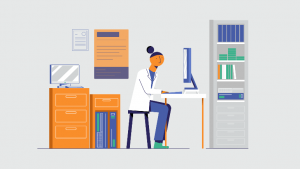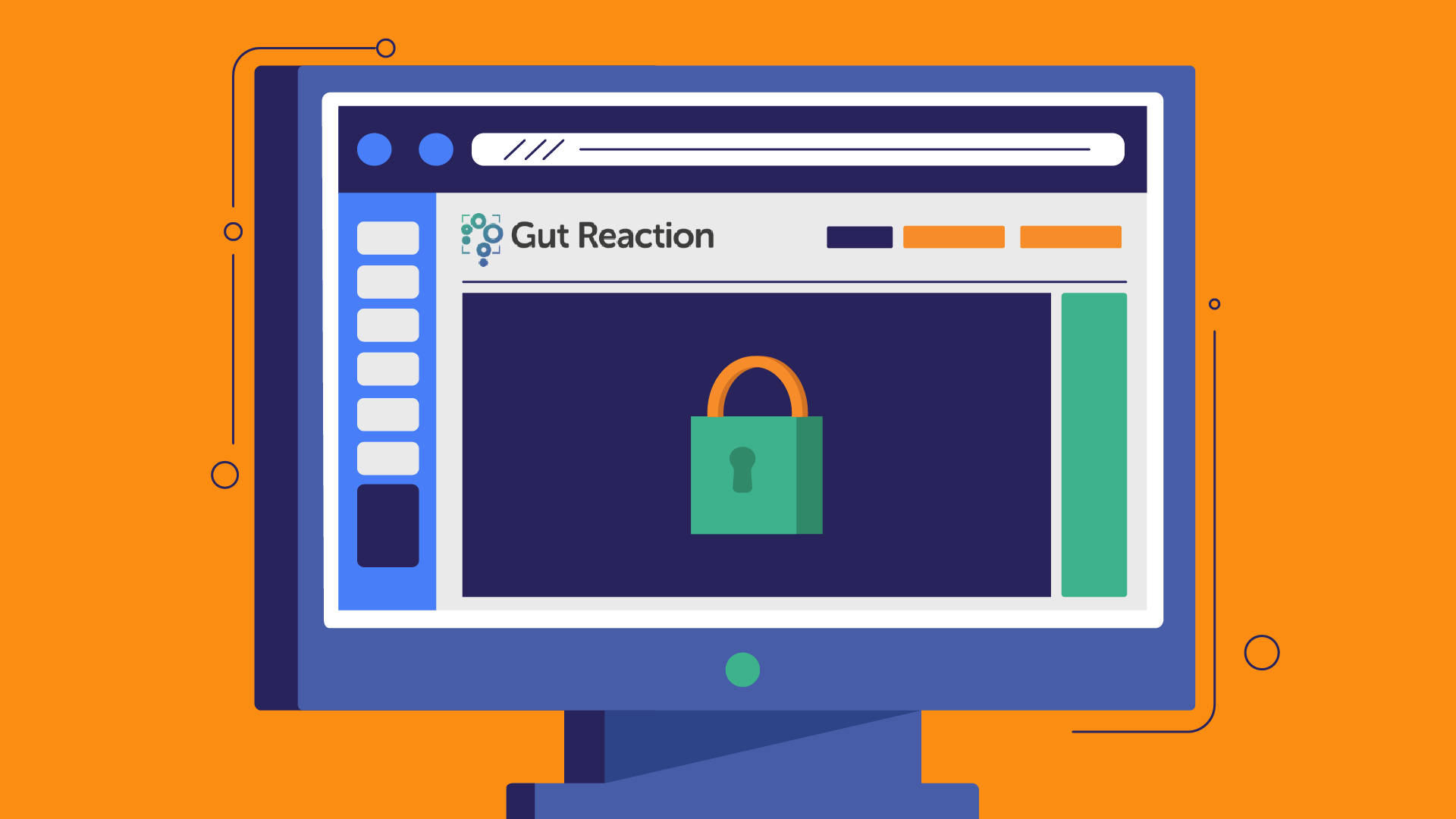Gut Reaction is a unique data resource designed to support academic and industry research in Inflammatory Bowel Disease (IBD). By working in partnership with the IBD community and experts in data safety, we aim to improve treatment options and patient outcomes through secure, transparent and responsible use of consented patient data.
We met with some of our team members to chat about how Gut Reaction ensure that data is always kept safe and private, and only supports research that is acceptable to patients living with IBD.
Our panel today:
Antony Shimmin – Senior Business Development Manager, AIMES, Part of the Arrow Business Communications Group
Caroline Brocklehurst – member of the Gut Reaction Patient Advisory Committee
Mark Robertson – Director of Customer Engagements, Privitar
Neil Walker – Chief Data Officer for Gut Reaction and Clinical Bioinformatics and Statistical Genomics Manager, NIHR BioResource
Neil, what do you think are the main challenges to using patient data for research? How does Gut Reaction ensure that all data is kept safe and used appropriately?
Information from medical records is an important resource for research, but it is also potentially sensitive. Without active consultation and involvement to ensure that our patients can share their views and experiences, projects like Gut Reaction aren’t possible. By working alongside our Patient Advisory Committee (PAC) we have been able to develop a model for Gut Reaction that supports research, but in a way that is acceptable for the individuals who allow their information to be used.
Gut Reaction employ several technologies to ensure that our data is used safely and appropriately; we de-identify patient information, making it very difficult to link data back to an individual, and by using secure computer-based spaces known as trusted research environments (TREs), alongside legal agreements, we can be confident that Gut Reaction data will not be copied, shared with third parties or misused.
We often hear the term de-identified in relation to health data, Mark please could you explain what this means
De-identification is a really important process in health data research; it is how we make sure that anyone who donates their information for health data research cannot be easily identified. For basic use cases, this can involve removing unique, sensitive details, such as name, date of birth or hospital number, and replacing it with a consistent key to link records from the same person together. When thinking about data privacy protection, you also need to consider details which could be used to determine someone’s identity or medical condition if combined with other datasets. So, in order to de-identify sufficiently, we must apply de-identification techniques to data fields such as dates and times for hospital appointments or types of treatment, making sure that they are not too exact. For example, date of birth and date of onset of IBD is not released, with ages turned into age-bands.

Mark, how does the Privitar computer software help us ensure that these private details are removed when de-identifying data?
Privitar software helps to make patient privacy a central part of the data research process, ensuring that the requirements for protecting personal details are agreed at the project start and rules are set. We provide a platform which offers a range of de-identification techniques that can be applied to datasets, controlling specific details which can be seen and used by researchers, and limiting access to sensitive information. This can be adapted for different study requirements or data types. Our software also allows for later re-identification if patients need to be contacted for follow up, but the details needed to do this are kept separately and securely. Taking this approach allows us to support Gut Reaction in finding a balance, protecting the privacy of anyone whose data is being used while allowing sufficient detail to remain, and important studies to go ahead.
We’ve heard from Neil that trusted research environments (TREs) are also an important part of how we keep Gut Reaction data private and safe. Antony, please could you explain what TREs are and how they help us ensure the security of our patient information?
TREs are a cloud-based technology (this means that they are accessed via the internet) designed to safely store information, while also enabling secure access for approved researchers. Our TRE contains specific tools for analysing data to support research, alongside control and monitoring technologies that prevent copying, downloading or unauthorised access to secured information. Together with de-identification, TREs are an important means of protecting the privacy of patients, and making sure that data is only used in an acceptable way, while also facilitating new studies and discoveries.
Neil, would there ever be a situation where we didn’t need to remove personal details? And is there an option for patients to share confidential details when they sign up to the NIHR BioResource?
The idea of personal details in this kind of research is complex. Healthcare information is personal beyond just names and addresses, and much of the data we use – such as genetics – is private, so we need to very carefully manage risk based on the proposed use. There are times when we need to be able to identify individuals; the NIHR BioResource links up participants with suitable research studies, and we have to be able to contact them for this purpose. Personal details have also been used to request information from the NHS Trusts participating in Gut Reaction, and from NHS central records. Anyone who joins the BioResource always has the option to change their mind and have their data removed, and they can also decide to not be involved in a specific research study if contacted.
We have clear and detailed policies on maintaining patient privacy and acceptability, and it’s one of the most important areas of my work.
 Caroline, the PAC have been crucial in helping us ensure that our work is acceptable to the IBD community, in terms of data safety and use. Can you tell us a bit about how this works for Gut Reaction?
Caroline, the PAC have been crucial in helping us ensure that our work is acceptable to the IBD community, in terms of data safety and use. Can you tell us a bit about how this works for Gut Reaction?
Since joining the Gut Reaction PAC, I’ve noted that patient feedback is not just welcomed, but actively sought, and as patient representatives we’ve often raised challenging points which have had a real impact on the project. The area I’ve contributed to most is data access; this has really advanced the role and level of input from patient and public representatives (currently the PAC and in future the Patient & Public Review Group [PPRG]). The data access process has moved away from simply having in mind patient input, to making patients and public central in the data access application process. For example, if a proposal mentions IBD it will have to go through the data access process with the scrutiny of the PPRG who will see the whole application, not just the lay summary so that we can challenge any aspects of the proposal.
The large size and diversity of perspectives within the PAC and PPRG also gives added weight, and the proposal goes directly for PPRG review. The PPRG makes recommendations to, and has representation on, the Gut Reaction Data Access Committee (DAC) for decision making. Importantly, feedback will go both ways in the process along with oversight from a National Panel with a large IBD patient representation. So, the data access framework has been designed to have transparency and best practice scrutiny, with authority of patient review in mind.
Caroline, what do you think are the most important considerations for patients when deciding whether a study should be approved or not?
Essentially, we understand that we, as patients, consent to give the ‘gift’ of our data in the hope that it could improve our and fellow patients’ lives through improved research to predict disease, prevent complications and to personalise treatment. However, that doesn’t mean we don’t have legitimate concerns about the use of that ‘gift’ and require assurances around issues of trust, ethics, control, governance, security and privacy. This is recognised in Gut Reaction.
We as patient and public representatives are challenging assumptions of researchers and data experts to communicate with us in a comprehensible way: What is the research for? What are the benefits? Is the data use necessary? Are there any risks in the data use for patients or the wider public? Has the diversity of the data requested been considered? How is the data going to be kept safe? By answering these kinds of questions, researchers and data experts need to provide assurances in an understandable way, giving confidence in all aspects of data use.
Antony, do TREs always work the same way and offer similar levels of protection? And is there an alternative approach to securely sharing health data for research?
The idea behind TREs is to offer a technical, highly controlled solution to balancing the need for the security and privacy with the huge research potential of healthcare datasets. TREs can provide complete control over who accesses datasets, what level of information can be seen and how a user can process the information held within the TRE; this makes them very adaptable for different projects.
Use of secure research environments, such as TREs, has become the accepted ‘gold standard’ for health data research, and here at AIMES we certainly believe that they are the best way to support vital research while protecting the privacy of individual patients.

Neil, Gut Reaction links data from different sources, in varying formats such as hospital letters, test results, reports and questionnaires. What exactly does the data look like when your team receives it, and does this change as you convert the information into a more usable form?
Some data, such as the questionnaires directly collected by the NIHR BioResource, come in a predictable, table-based form, but other sources of information can be very variable and this presents a big challenge for my team. We receive data in many formats from NHS hospitals, and it can take some time and effort to accurately transfer the trickier types such as scanned letters and reports into a standardised, usable form.
The first task is to break up any scanned documents into text, and remove any identifiable details. By replacing an individual’s name, date of birth or hospital number with a barcode or number we are still able to perform one of our key tasks – linking information from different sources – while reducing the risk of it being identifiable. Each person’s hospital records must be clearly labelled so that they receive the correct treatment, so it’s a big task to make sure that any details that identify an individual and might present a risk to privacy within these files are removed.
Neil, this sounds extremely challenging! What is the biggest technical issue when working with such large amounts of information from different sources?
The greatest challenge is probably the safe transfer of information from NHS Trusts to the NIHR Bioresource. Patient privacy and safe use of data is quite rightly taken very seriously, and there are multiple layers of protection within hospitals (known as ‘information governance’) to ensure that this is done correctly. Meeting all of these requirements for the multiple hospitals involved in Gut Reaction, who often have slightly different approaches and store their data in distinct ways, is time consuming and can present quite a challenge for my team.
Some Trusts have sent us data in discrete parcels: lab tests in one dataset, clinical reports in another, letters in a third. Others have sent us all this data merged together for each of their patients. For Gut Reaction data to be useful for research it needs to be consistent in the ways that it is presented and stored, and this is a very big job!
Caroline, these are complex ideas to share. Do you think that the idea of data safety, and the measures that are needed, have been well communicated to the members of the public? What more could Gut Reaction, and other similar projects, do to ensure that as many people as is possible are comfortable with this type of research?
They certainly are complex! Within PAC and the PPRG there is always the challenge of maintaining our independent lay perspective, but also ensuring we have the information and tools to make our reviews and recommendations informed and meaningful. We’ve had support through patient and public involvement and induction training, as well as ad-hoc development in diverse areas such as patient-led research and the hot topic of artificial intelligence, among other areas. We benefit from a Gut Reaction data expert ‘translator’ (usually Neil) at PPRG meetings to explain technical aspects as needed.
Gut Reaction is trying to make its work more broadly accessible and has communication with public through webinars, articles such as this, the Gut Reaction and partner websites and social media, milestone updates etc. Also, the PPI training programme developed to support Gut Reaction PAC and PPRG members, is available to all on the Crohn’s & Colitis UK website. I know that the project is continuing to look at ways to give patients more control of their data safety through technology as well as consent mechanisms, and we patient representatives will continue to challenge Gut Reaction to make this as effective as possible.
There is lots of work ongoing industry-wide to establish best practice frameworks and accreditations in this area to give the public confidence. Gut Reaction and similar projects need to ensure that they are proactive in developing and communicating these assurances to patients and the public to give the confidence that the ‘gift’ of their data is as safe as possible in the goal of better research.
Thank you to our panel! You can find more information about how Gut Reaction work to ensure that patient data is used safely and accountably here, and more information about our partner organisations here.





